Japanese acupressure massage...
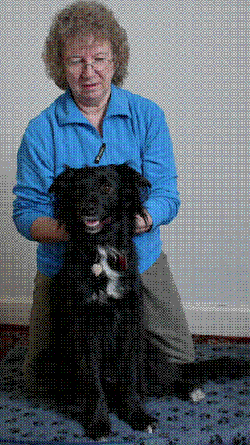 Each
year Jean Davidson works her Shiatsu magic on new and returning handlers and their
dogs around the agility circuit in Scotland. She has noticed that quite a few of the dog problems
would seem to be related to the handler as well as the dog as if they were being transferred
down though an invisible lead. She explains how it works... Each
year Jean Davidson works her Shiatsu magic on new and returning handlers and their
dogs around the agility circuit in Scotland. She has noticed that quite a few of the dog problems
would seem to be related to the handler as well as the dog as if they were being transferred
down though an invisible lead. She explains how it works...
Shiatsu is a holistic therapy which takes into account the whole person or dog - what is going on in
their life, work
and play and how the environment they live in effects how they are. One of the many benefits of
Shiatsu sessions is becoming more aware of our own body and how our life impacts on our health.
The same is relevant to our relationship with our dogs.
In the West, our doctors and vets work with the symptoms we present, prescribing
proven medication to cure the problem. A Shiatsu practitioner's role is to work with clients to
help them by looking at their whole situation to find the root cause, if possible, and then
work together remove it. For example, it may be the handler's competitiveness that is putting
pressure on the agility dog, causing the worry or anxiety. Raising awareness of this the
handler can work to find a way of avoiding this going down the lead improving the handler/dog
connection. Nine times out of ten this leads to improved performance.
The most usual complaint is 'My dog keeps taking down poles. I don't understand why.'
When I examine the dog, I often find either an anxious dog with tight shoulders
who is taking down poles with its front legs or a dog that worries about everything that is
going on and takes down poles down with its hind legs.
Why you might ask?
Chances are that a dog that is continually worrying about getting it right for their
handler will have tight stomach muscles. Think about it. When you worry about things do you get
a really tight knot or butterflies in your stomach? Dogs are no different. They too get this
tension in the stomach and need to be relaxed to help them prepare for jumping. Put yourself in
your dog's position. Yes, I mean on all fours, tense up your stomach. Now think... would you
want to take off and jump? I wouldn't nor does your dog.
Now change your thoughts to being afraid, a bit anxious, what
happens to your body you tighten your kidney area, bring your back down and tense your
shoulders to fight off whatever the problem is. What happens to you? You get a headache,
tense neck and shoulders feel very ‘up tight' so do the dogs therefore when they take off to
jump they don't lift their front legs properly taking poles down as they approach the jumps. Relaxation is needed this time the shoulders, neck and kidney area.
Most of the dogs I work with belong to agility competitors. However, I do have the occasional vet
referral which I treat in the same way, gathering information about the whole dog (occasional
cat and recently a pony) to find out what has happened in the past that could have triggered
the problem. As Shiatsu works to relax the soft tissue, it allows the skeletal systems to realign naturally. This is the area where I receive vet referrals as this is not their specialism. For example,
elderly dogs with stiff joints can be assisted with gentle stretches and joint opening to
maintain good circulation. Younger dogs with tendonitis and unknown causes for lameness have
improved quicker with Shiatsu treatments.
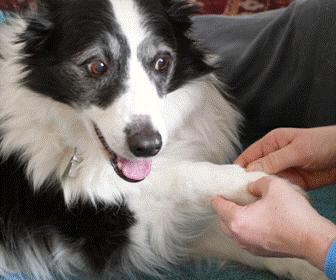 How it works How it works
Shiatsu literally means finger (shi) pressure (atsu). I mainly use my thumbs to access
acupoints and move stuck energy along the
meridian to the next point, giving an impression of a relaxing massage. It is the same system
as acupuncture but without the needles
When the body is relaxed, it can start to heal itself. Take breathing for
example. Occasional deep breaths provide much needed oxygen to the muscles, improving aches and
pains and giving that sense of wellbeing. I've found this is the same in both people and dogs.
In The Well-connected Dog by Amy Snow & Nancy Zidonis, they say,
Casework has shown consistently that acupressure
can enhance your dog's comfort, emotional stability, and overall health, specifically,
acupressure can:-
-
Relieve muscle spasms
-
Build the dog's immune
system
-
Release endorphins
necessary to reduce pain
-
Release natural cortisone
to reduce swelling
-
Enhance mental clarity
required for focus in training and performance
-
Resolve injuries more
readily by removing toxins and increasing blood supply'.
My three study years concentrated on work with people. My family dogs also
enjoyed me practising on them. This led me to use Shiatsu for dogs as my final year
dissertation. From there, I went on to include work with dogs and ultimately I set up in
business.
In both people and
dogs working to open shoulders making space for the scapula to move freely releasing stuck ki,
improving circulation to deep muscles. This opens the chest area aiding breathing, lowering
shoulders and releasing tension and toxins in the whole area. This makes people and dogs relax
and feel good. For people getting to know how the body feels when relaxed is important then
they can realise when the body is out of balance under stress.
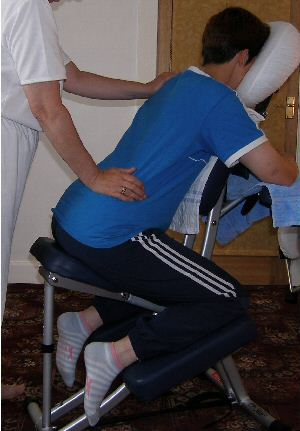 Short
case studies Short
case studies
Some examples of agility dogs and
people I have treated include:-
Female with long standing
fibromyalgiaI
I worked to relax this client and to allow her the space to be still as she is always on
the go tending to her horses. Along with meridian point work, I used gentle stretching and
opening of her joints, thus releasing toxins and improving her feeling of well-being. After
her second session she said she felt easier and had fewer aches and the headaches were
gone.
Labrador bitch
(12 years) with degenerative myelopathy (DM))
This dog was crossing her the hind legs when walking and her toes were turning under hind
feet so badly that the middle two claws were worn down. I worked to massage the legs from the
knees up to the rib area, using meridians in the back and legs, gentle stretches of the legs
and toes. When she stood up, her hips were even and she walked out without crossing her legs.
On her next visit, her owner reported that the dog was managing short walks without crossing
her legs and there was less turning under of her toes. To prove this, she showed me that the
claws. The middle two toes had started to grow again.
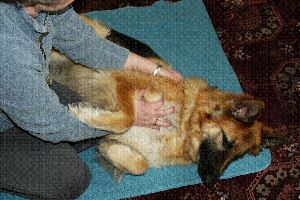 GSD
Rescue Bitch (6 years) GSD
Rescue Bitch (6 years)
This dog was very hyper and anxious, taking time to settle and only for a few minutes at
a time. After just one session, the owner saw a change in the dog and felt she was settling
down less agitated. When she returned for her second session, she settled more easily. I
worked point to calm her and let her know it was okay to relax. At subsequent sessions she
comes in really pleased to see me and relaxes for me to work on her.
Elderly client
with arthritis
When treating this lady she asked me 'How come my legs and other joints move for you?'
My answer is because they are not weight bearing. After her sessions, she feels more able to
move. Shiatsu practitioners believe it is the movement of stuck Ki taking the circulation to
areas where it had been restricted. After another four or five session, she made another
observation that her acid reflux* was gone. (She hadn't told me about this.) In Oriental
medicine, joint problems and acid reflux belong to the same element. The emotion for this is
frustration and anger. Arthritis is known to be triggered by emotional problems as is acid
reflux. She was very pleased to be free of this annoying problem.
* Acid reflux is when acid from the
stomach leaks up into the gullet (oesophagus). This may cause heartburn and other symptoms.
My background in training and development has led me to the next step, developing courses for
handlers to explore Shiatsu for Dogs. The sessions enable handlers to work with their own dog,
building an
important connection between them. I also have a course for Shiatsu practitioners (people and
equine) to enable transfer of skills and knowledge to working with dogs.
If you would like any
further information about this or anything else that my article has raised contact details can
be found on my website or visit me at one of the 2011 events details also on website. It is, however, important to remember that if your dog is unwell, you must visit your
vet first.
Shiatsu is a complementary therapy and not a substitute for the vet. It works to complement the
veterinary practise not replace it.
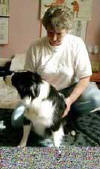 About
the author... About
the author...
Jean Davidson MRSS, MIACE,
Chartered MCIPD
trained with Aberdeen Collage of Shiatsu, graduating after three years of study.
While studying Shiatsu, she discovered
it wasn’t just people who loved shiatsu touch. Her family dogs also wanted to be worked on. It
seemed natural, therefore, when choosing a subject for her dissertation that she chose shiatsu
for dogs. This was in 2003 - and still is a fairly new concept. Many practitioners work with
horses. Jean is the only one working with dogs in Scotland withdogs and she knows of another
one who works with horses and dogs in South-West England.
Dogs have always been part of Jean life
even when she was a wee girl. When she married it was 'love me. love my dog. The dog happened
to be a Cairn terrier. Since then, her family always includes more that one canine pal - first
Cairn terriers, then border collies and German Shepherd Dogs (GSD). At present she has two
Border Collies (aged 15 and 6) and a GSD (almost 2). She has been attending agility training
since the GSD was 14 months old, but they have haven't yet made it to competitions - maybe
later this year.
Jean's daughter-in-law is an agility
handler so she tapped in to the circuit in 2004 and continue to take Shiatsu to dogs and
handlers at agility events from April – August each year around the East of Scotland. In 2007,
people began asking if she would run workshops to help them work with their own dogs. Using
her background in training and development, Jean designed three courses that she runs from home
or at other suitable venues.
The courses are:-
-
Introductory Shiatsu for Dogs – a one day
workshop for dog handlers/owners who want to work on their own dogs
-
Basic Shiatsu for Dogs – Dog handlers/owners
meet one weekend a month for three months to improve their understanding of their own dog.
This course includes basic anatomy, physiology and some pathology related to dogs
-
Shiatsu for Dogs Practitioners – This course
is for Shiatsu practitioners who have completed minimum of 1st year as well as Equine Shiatsu
practitioners. The length of this course is flexible, relevant to prior learning. It aims to
help with the transfer of learning to work with dogs
Learn about Shiatsu and help improve the connection between you and your dog.
Training for dog handlers/owners, Shiatsu Practitioners and Equine Shiatsu Practitioners
Further information see website:
www.shiatsufife.co.uk
|